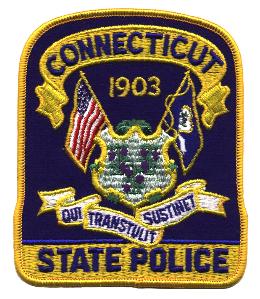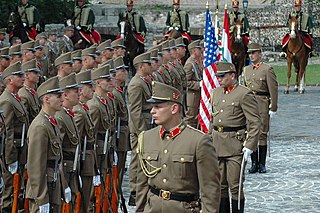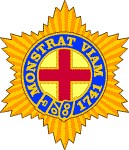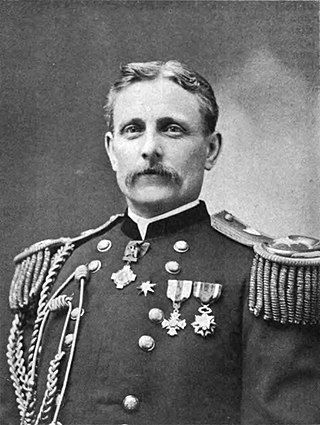
The United States Coast Guard Academy (USCGA), located in New London, Connecticut, is the U.S. service academy specifically for the United States Coast Guard. Founded in 1876, the academy provides education to future Coast Guard officers in one of nine major fields of study.

The kepi is a cap with a flat circular top and a peak, or visor. In English, the term is a loanword from French: képi, itself a re-spelled version of the Alemannic German: Käppi, a diminutive form of Kappe, meaning 'cap'. In Europe, the kepi is most commonly associated with French military and police uniforms, though versions of it were widely worn by other armies during the late 19th and early 20th centuries. In North America, it is usually associated with the American Civil War, as it was worn by soldiers on both sides of the conflict.

A bearskin is a tall fur cap derived from mitre caps worn by grenadier units in the 17th and 18th centuries. Initially worn by only grenadiers, bearskins were later used by several other military units in the 19th century. The bearskin cap continued to see use in battle during the mid-19th century, although by the 20th century, it was only used for parade dress. In the 21st century, the bearskin cap is retained by select military units as a prominent element of their ceremonial and full dress uniforms.

The Connecticut State Police (CSP) is the state police and highway patrol of the U.S. state of Connecticut, responsible for statewide traffic regulation and law enforcement, especially in areas not served by municipal police. It is a division of the Connecticut Department of Emergency Services and Public Protection. The CSP currently has about 875 troopers as of June 28, 2022 and is headquartered in Middletown, Connecticut. The Connecticut State Police is also responsible for protecting the Governor of Connecticut, Lieutenant Governor of Connecticut, and their families.

The United States Cavalry, or U.S. Cavalry, was the designation of the mounted force of the United States Army. The United States Cavalry was formally created by an act of Congress on 3 August 1861 and ceased as a distinct Army branch in 1942. The name "cavalry" continues to be used as a designation for various specific United States Army formations and functions.
The Imperial Guard of Japan has been two separate organizations dedicated to protection of the Emperor of Japan and the Imperial Family, palaces and other imperial properties. The first was the Imperial guard divisions, a quasi-independent elite branch of the Imperial Japanese Army, which was dissolved shortly after World War II. The current organization is the Imperial Guard Headquarters, a civilian law enforcement organization that is part of the National Police Agency.

Public duties are performed by military personnel, and usually have a ceremonial or historic significance rather than an overtly operational role.

Full dress uniform, also known as a ceremonial dress uniform or parade dress uniform, is the most formal type of uniforms used by military, police, fire and other public uniformed services for official parades, ceremonies, and receptions, including private ones such as marriages and funerals. Full dress uniforms typically include full-size orders and medals insignia. Styles tend to originate from 19th century uniforms, although the 20th century saw the adoption of mess dress-styled full-dress uniforms. Designs may depend on regiment or service branch. In Western dress codes, full dress uniform is a permitted supplementary alternative equivalent to the civilian white tie for evening wear or morning dress for day wear – sometimes collectively called full dress – although military uniforms are the same for day and evening wear. As such, full dress uniform is the most formal uniform, followed by the mess dress uniform.

A guard of honour, honor guard or ceremonial guard, is a group of people, typically drawn from the military, appointed to perform ceremonial duties – for example, to receive or guard a head of state or other dignitaries, the fallen in war, or to attend at state ceremonials, especially funerals. In military weddings, especially those of commissioned officers, a guard, composed usually of service members of the same branch, form the sabre arch. In principle, any military unit could act as a guard of honour. In some countries, certain units are specially assigned to undertake guard of honour postings or other public duties. Republican guards, royal guards and foot guards frequently have ceremonial duties assigned to them.

The Kremlin Regiment, also called the Presidential Regiment, is a unique military regiment and part of the Russian Federal Protective Service with the status of a special unit. The regiment ensures the security of the Kremlin, its treasures, and state officials. In accordance with the federal law of December 8, 1997 "On Immortalizing the Soviet People’s Victory in the Great Patriotic War of 1941–1945", the regiment also maintains a guard of honor at the eternal flame of the Tomb of the Unknown Soldier. The regiment is housed in the historic Kremlin Arsenal.

The United States Army Old Guard Fife and Drum Corps is one of four premier musical organizations of the United States Army. Members perform using musical instruments and wearing uniforms similar to those used by military musicians of the Continental Army during the American Revolution.
The United States Coast Guard Band is the premier band representing the United States Coast Guard and the Department of Homeland Security. Established in 1925, the Coast Guard Band is stationed at the U.S. Coast Guard Academy in New London, Connecticut. The Band frequently appears in Washington, D.C., at presidential and cabinet-level functions on formal and informal occasions. Once a year, it undertakes national and international tours to promote the Coast Guard.

The Commander-in-Chief's Guard, commonly known as Washington's Life Guard, was a unit of the Continental Army that protected General George Washington during the American Revolutionary War. Formed in 1776, the Guard was with Washington in all of his battles. It was disbanded in 1783 at the end of the war.
The Governor's Guards of Connecticut are four distinct units of the Connecticut State Guard, a part of the organized militia under the Connecticut State Militia. There are two foot guard units and two horse guard units. All four units are formed fully of volunteers and serve under the authority of the Connecticut Adjutant General and the Governor of the State of Connecticut, who serves as the Guards' Commander-in-Chief.

The Veteran Corps of Artillery is a patriotic organization established as an independent artillery unit in 1790 at New York by veterans of the Revolutionary War. In 1848, it consolidated with the Military Society of the War of 1812.

The First Corps of Cadets of Massachusetts formed in 1741. Its motto is Monstrat Viam - "It Points the Way." While it has served in several wars, the sub-unit's primary contribution to Massachusetts and to the United States was as an officer-producing institution for new regiments from the Revolutionary War through World War II.

Honor Guard Battalion is a military unit of Armed Forces of the Republic of Croatia that performs protocol tasks for the needs of top-level state and military officials, as well as tasks related to the protection and security of the Commander-in-Chief. It consists of up to 300 members, all being professionals. The unit is under direct command of the General Staff of the Armed Forces.
The following is a timeline of the history of the city of Hartford, Connecticut, USA.

Kenneth F. Cramer was an American politician and United States Army major general who served as Chief of the National Guard Bureau.

George Malpas Cole, was the thirty-second Adjutant General of the State of Connecticut. He was the son of George Cole and Jane A. Malpas. Born in Portsmouth, England, his family moved to Massachusetts where his father was a civil engineer. Cole was educated in public and private schools. Cole was also tutored by his father, where he became an assistant to his father. Cole would later become associated with a wholesale and a grain business in New London.
















